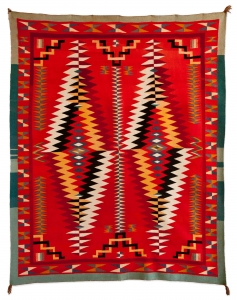Navajo Weawing
For over three centuries, Navajo weaving has been esteemed for its beauty and technical excellence. Various historic influences converged which allowed their weaving skills to develop. In the 17th Century the Spanish imported their Churro Sheep from Spain which produced superb, long staple yarn which was ideal for weaving, and the hunter-gatherer life-style of the Navajos was suited to sheep herding. The Navajos learned the art of weaving from their interaction with the Pueblo Indians and adopted their simple, portable, vertical loom. Through the trade routes from Mexico, the Navajos were exposed to the designs of the Mexican Saltillos, and they also obtained indigo dye and red bayeta cloth which added color to their blankets. The initial textiles they wove were items of clothing. The beauty of these blankets was so admired by other tribes that they traded for these “Chief Blankets” which reflected great prestige on the owner. As Indian Traders settled the land and the railroads pervaded the territory, Navajo blankets became less items of clothing and more items of trade. Gradually they were transformed into rugs for the Anglo tourist market with many design elements influenced by the Reservation Traders. The introduction of commercial Germantown yarns and aniline dyes greatly expanded the color palette of Navajo textiles. Over the course of history the Navajos have continually integrated cultural changes and exposure to changing everyday life into their weavings. They have incorporated new yarns, new dyes, new design elements, and new market demands that result in a continually evolving art form of the highest order. Today Navajo weaving it still a vibrant, artistic expression.






